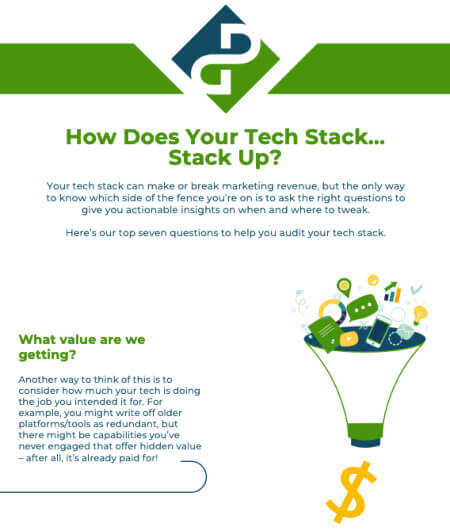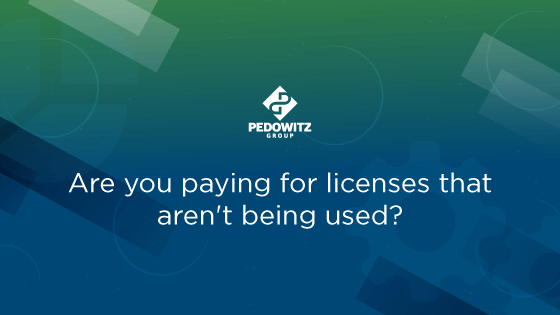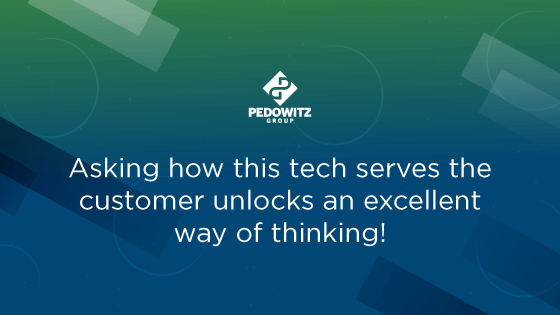Part of what we do is work with clients to assess their pain points and to help them leverage their processes and technology to conquer those challenges. We do it all the time, but sometimes even we miss things that are hiding in plain sight!
In a humbling example, we took a look at our own tech stack recently and noticed that a segment of the records in our current database weren’t viable. We'd been wasting money for unnecessary capacity and the opportunity to maintain those records ... only to find out they were actually costing us money instead of helping to drive revenue!
A long overdue audit of a key piece of revenue technology, or RevTech, revealed what was likely the biggest difference maker we could make when it came to ROI on our tech spend and impact to pipeline.
When was the last time you audited your tech stack? Not just marketing and sales, but all that relates to these systems.

Take it a step further: When was the time before that? (Do you regularly check your entire stack?)
If you cocked an eyebrow or tilted your head sideways slightly, this blog is for you. Let’s dig into a handful of questions you can start asking today to uncover potential wasted budget, critical data gaps, or ways to strengthen your teams.
But first…
Why this matters: Revenue impact
In our RevOps report conducted with Ascend2, we found that only 13% of respondents said technology optimization at their company was “excellent.”
How’s this impact revenue, you ask?
- 25% of those surveyed said missing / inadequate tech is a top challenge to improving their customers' experience
- Nearly 1/3 cited this is a key need for better communication between teams – and creating a unified view of the customer
- We saw a 3x response rate of “excellent” for companies in growth mode
In other research by Ascend2 and Anteriad, they found 61% of marketers said their tech stack was "too complex."
In short, if you want to provide a better customer experience, understand them better, and drive stronger cross-functional collaboration …
…then you need to curate your tech stack!
Related: Get a quick-hitting audit of yours ... right now.
Question 1: What value are we getting?
This is different than identifying and measuring a given technology's ROI. Quite simply, is the system successfully serving the purpose you got it for?
You’d be amazed at how often the answer is “no.” But the reasons for this can be many, ranging from new org structures to a company buying the right tech for the right problem, but not having it implemented properly.
We see it all the time with our clients, who keep adding and doing more and more, but finally realize they're overwhelmed with platforms to manage - with many of those platforms not doing everything they could be (even if they were bought for the right reason).
One way to begin categorizing
Start by identifying every platform you have, and place each into one of the following uses:
- Improve Customer Centricity
- Support Revenue Growth
- Enable Operational Excellence
Only select one per platform. If you’re unsure, go with your gut or take a team vote. This can be useful in seeing where a gap in your stack may be, or where you might have too much bloat.
For example, perhaps you have a technology that automates some critical reporting for the team, saving them dozens of hours since they don’t have to engage in manual reporting. That’s enabling operational excellence.
But if you have two tools used by different parts of the business that do this same function, perhaps you’ve identified a redundancy, which means - drumroll, please - potential cost savings! We actually go deeper in our audits with multiple sub-categories, but this is a great starting point.
Are you actually using all it has to offer?
Too often, this is an emphatic “no!” But if you’re paying for the tool, shouldn’t you be using everything you can?
Often in audits, we find it’s not a matter of desire, but either a lack of understanding of all that’s fully available or a combination of lack of time + competing priorities that prevent teams from maximizing their tech use.
If you're unsure about how you're using your tech, you're not alone - it's actually quite common! Engaging with an independent expert can provide a roadmap to getting these answers and identifying potential wins – without making any major changes.
Additionally, it can stop wasteful spending on new platforms when you have paid-for tech that offers the same capabilities you’re seeking to fulfill elsewhere. Remember that an investment in comprehensive training on key tools can pay dividends many times over.
How would we measure ROI?
For some tech, it will be difficult to show data-driven ROI. A great example could be a data warehouse, or even your CRM!
It’s hard to say how a CRM contributed dollars to revenue, but what we focus on in our audits is if this tech is doing its intended job to the best of its ability. Also: Could we be getting more from it in other areas of the business?
In the case of a data warehouse, you may need to centralize data for a multitude of reasons and so it enables some operational excellence – even if the tie to revenue is difficult to express.
Question 2: Who uses it?
Just because you're paying for seven seats doesn’t mean seven people are using the tool.
What’s the true level of adoption in your company – and what are gaps that are leaving gains on the table?
For teams that work together: Are they using the same tools, or are disparate systems operating in a siloed environment?
Even if a tool itself is vital, you may be paying for access that isn’t needed (such as too many seats / licenses), or it may be misused in parts of the business.

Question 3: What’s on the market now?
Considering everything you do on a day-to-day basis, it’s easy to miss the market’s evolution. Sometimes, there really is a better alternative to what you’re using that was released fairly recently.
- Conversational marketing?
- Intent data?
- Automated outreach?
- Sales enablement?
- Scheduling software?
The list goes on and on. There’s more options now than there has ever been – it’s a buyer’s market, so glancing at options my end up saving you budget.
Question 4: How is it currently integrated with our stack?
There are two ways to approach this, and both are important.
The first is looking at data. How does data flow between a particular system or become enhanced / changed when it passes into others?
For example, does your intent data platform provide an input into lead scores, or does your conversational marketing platform actively enhance lead records when data is matched?
The second is process. How do key processes funnel through a given piece of technology? How vital is that touchpoint?
A common one is lead management, which can touch MAP and CRM but also pull in from data enrichment providers, intent data, etc.
One caveat:
Not all tech modifies data, but it can impact different processes. For example, a tool like Slack or MS Teams can serve its primary purpose without any other integrations – others in your stack (like an audience research tool) could be the same.
Can you improve this, and what would that cost?
We see countless examples of poorly-integrated technology hindering teams from doing all they can to move the revenue needle. And it’s not just MAPs and CRMs, though those are still common (believe it or not) – it’s anything from data providers to analytics that need a once-over to fully enable them.
But since you may not be using the full gamut of available options, it's fair to ask: If you fully optimize, will you (or other teams) actually use it?
And what will the cost be to realize those gains?
Understanding these gaps (and what's worth investing in) is key to determining just how valuable a piece of technology is to your business.
Question 5: What would happen to the customer experience if we got rid of this?
Perhaps the most customer-centric question you can ask!
Think about it: If you’re a prospect or customer and this technology was gone tomorrow, how would they be impacted?
And as a follow-up … how easily could you fill any gaps this tech leaves in the person’s experience?
For example, let’s say you use a chatbot on your site. What would happen if you got rid of it?
Potentially nothing. Or - based on your analytics - potentially a lot of great customer service that leads to happier customers (and thus, higher retention).
But also, how would the organization be impacted?
Remember those categories at the beginning?
- Improve Customer Centricity
- Support Revenue Growth
- Enable Operational Excellence
Those last two can be impacted by streamlined internal processes, less tech strain, etc. Even if the customer won't see the impact of a piece of tech being removed, would this make it harder (or easier) for your teams to be able to serve that customer?

One example: Project management tools. Customers won't interface with it, but your teams may be far more organized and better aligned from using it!
How do we want our CX to evolve?
This is a core question we ask clients when auditing.
A client may want to be more personalized in communications. As a result, we'll need to centralize data to make informed decisions, likely add a predictive platform or rules engine, and then integrate data into the various systems already in place."
The natural follow-up leads to questions about what the right tech may be and if you have that in place.
Since an architecture / tech stack is part of multiple pillars (People, Process, Tech, Strategy), then a deficiency is any one of those prevents the full value being realized. This means that sure, the tech isn't providing its maximum value, but the tech itself isn't to blame and could in fact provide more value with other improvements in the business.
Question 6: How easily could we replace it?
Typically, if the tech is providing value, is easy to use, and provides an absolute must for either the customer or the team, you aren’t asking this question.
You should anyway, even if only as a beneficial thought exercise.
Don't get me wrong: The cost associated with the time, resources, and headaches of migrating onto a new platform can be significant.
But too often, we see teams overestimate that cost. Unless you’re overhauling a core system such as a CRM, the pain may be far less than you anticipate (it’s also a great topic to ask a competing vendor).
Even if you don’t have the appetite (or resources!) for a change right now, it’s still worth asking the question and identifying what your particular pains might be. It’s possible that what you discover will be invaluable, even if it’s in a future fiscal year.
The great part? This is a Friday afternoon, my-brain-is-fried type of activity. Just type in "platform x competitors" and see what pops up on sites like G2 Crowd, TrustRadius, etc.
Question 7: What’s the opportunity cost of keeping this technology?
Every leader is working within a set of constraints: budget, people, etc.
If you discover something in your tech stack may not be providing the value you’re hoping, run with that thought a step further:
If you get rid of the tech, what could you do with that money?
For example, let’s say your team piloted ABM. It didn’t move the needle, maybe because you didn't have the sales and marketing alignment needed (or you never read this handy primer, but I digress).
Could you ditch your intent data platform? Could you replace a couple of functionalities with something far cheaper?
This is just one example, but you can imagine the potential cost savings if 2-4 technologies are identified as more replaceable than you once realized!
What to do right now
If it’s been awhile, you’re overdue to start your tech stack audit! Here’s a few suggestions:
- Gather a spreadsheet together collating what technologies are used, their cost, renewal dates, who uses them, and what they’re integrated with
- Once finished, grab time with key stakeholders to review each technology. It may be a long meeting, so prep attendees accordingly (or schedule 1-on-1s with them to go through the document)
- Keep this question front-and-center: What changes can we make that are best for our customer?
Need a helping hand? Try our technology consulting services!



